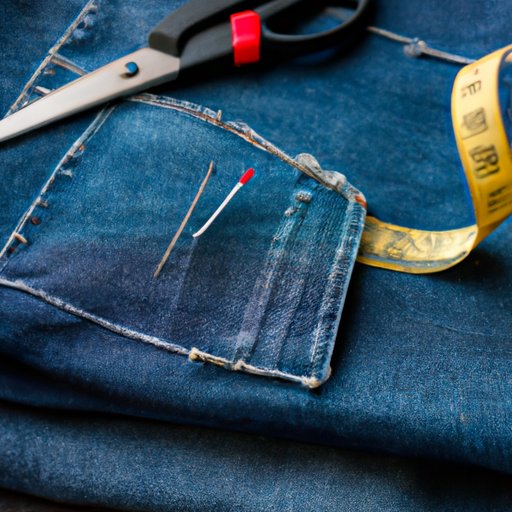Introduction
Jeans are a staple in any wardrobe, but finding the perfect fit can be a challenge. One common problem is that they’re often too long. Hemming jeans can seem daunting, but it’s actually an easy process that anyone can do with a little practice. In this article, we’ll provide a step-by-step guide to hemming your jeans, explain common mistakes to avoid, and offer tips for different hemming styles and tailoring options to get the perfect fit.
A Step-by-Step Guide to Hemming Jeans
The first step in hemming your jeans is to gather the necessary tools and materials. You’ll need a ruler or tape measure, sewing pins, a pair of scissors or fabric cutter, and a sewing machine with a denim needle. To measure the right length, put on the jeans and fold the excess fabric up until you reach the desired length. Pin the hem in place and mark it with a fabric pencil. Take off the pants and measure the distance from the bottom to the hemline to make sure it’s even on both legs.
To start hemming, turn the jeans inside out and fold the edge up to the marked hemline. Pin the hem in place, making sure it’s even and straight. Sew a straight stitch about 1/8 inch from the top edge of the hem, removing pins as you go. Fold the hem up once more, and sew another straight stitch about ¼ inch below the top edge. Press the hem in place with a steam iron and trim any loose threads.
How to Hem Jeans Without a Sewing Machine
If you don’t have a sewing machine, you can still hem your jeans by hand. The most basic stitch for hemming is a whip stitch. To do this, thread a needle with thread that matches the color of your jeans. Tie a knot at the end of the thread. Sew in and out of the fabric along the hemline about ¼ inch apart, pulling the thread taut as you go. Knot the thread at the end and trim off any excess.
If you prefer a stronger stitch, try the backstitch. This involves sewing backwards on every other stitch to create a tighter seam. To start, bring the needle up through the fabric at the hemline. Sew backwards for about ¼ inch and bring the needle up through the fabric again at the end of the backwards stitch. Sew forward to complete the stitch, then go backwards again on the next stitch. Continue this pattern until you’ve hemmed the entire pant leg.
An even easier option is hemming tape, which allows you to hem your jeans without any sewing. Simply fold the jeans up to the desired length and apply the tape along the hemline. Press the hem in place with a steam iron, and you’re done!
Top Mistakes to Avoid When Hemming Your Jeans
One of the most common mistakes when hemming jeans is cutting them too short. Always measure twice and cut once to ensure you get the right length. Another mistake is hemming unevenly, so make sure to measure each leg individually and double-check your markings. Hemming at the wrong angle can also cause problems, so make sure the hemline is straight and matches the angle of the original hem.
If you do make a mistake, don’t worry – it can often be fixed. If the pants are too short, you can add a strip of fabric to the hemline to give them more length. If the hem is uneven, you can adjust it by re-pinning and hemming again. Be patient and take your time to ensure a perfect result.
Different Hemming Styles for Jeans
There are many different hemming styles you can choose for your jeans, depending on your personal style and the occasion. The most traditional hemming style is the double-fold hem, which involves folding the hem up twice and sewing a straight stitch all the way around. Another classic option is the rolled hem, which is folded once and then rolled up again to create a cuff.
For a more edgy look, try a raw-edged hem or a frayed finish. Simply cut off the excess length with scissors and pull out the threads along the hemline. This creates a frayed effect and gives your jeans a distressed look. You can also try adding embroidery or patches around the hemline to give your jeans a unique touch.
Tips for Making Your Hemming Last Longer
To make your hemming last longer, it’s important to reinforce the hemline. You can do this by using fusible interfacing on the inside of the hem, which will add extra stability and prevent fraying. Choose a strong thread like topstitching thread in a matching color to ensure a durable hem. You can also try using a double needle when sewing the hem, which creates two parallel rows of stitching for added strength.
Tailoring Your Jeans to Fit Perfectly
If you want your jeans to fit perfectly, consider tailoring them to flatter your unique shape. You can adjust the hemline to hit at just the right spot on your leg, or taper the leg to fit your calves better. You can also take in the waist or hips for a more comfortable fit, or even add darts to remove excess fabric in the back. Don’t be afraid to experiment and find the perfect fit for your body.
Conclusion
Hemming your jeans is an easy process that anyone can do with a little practice. By following our step-by-step guide and avoiding common mistakes, you can achieve perfectly tailored jeans in no time. Experiment with different hemming styles and tailoring options to find the perfect fit for your body and personal style. With a little creativity and patience, you’ll have a wardrobe full of perfectly hemmed denim.
